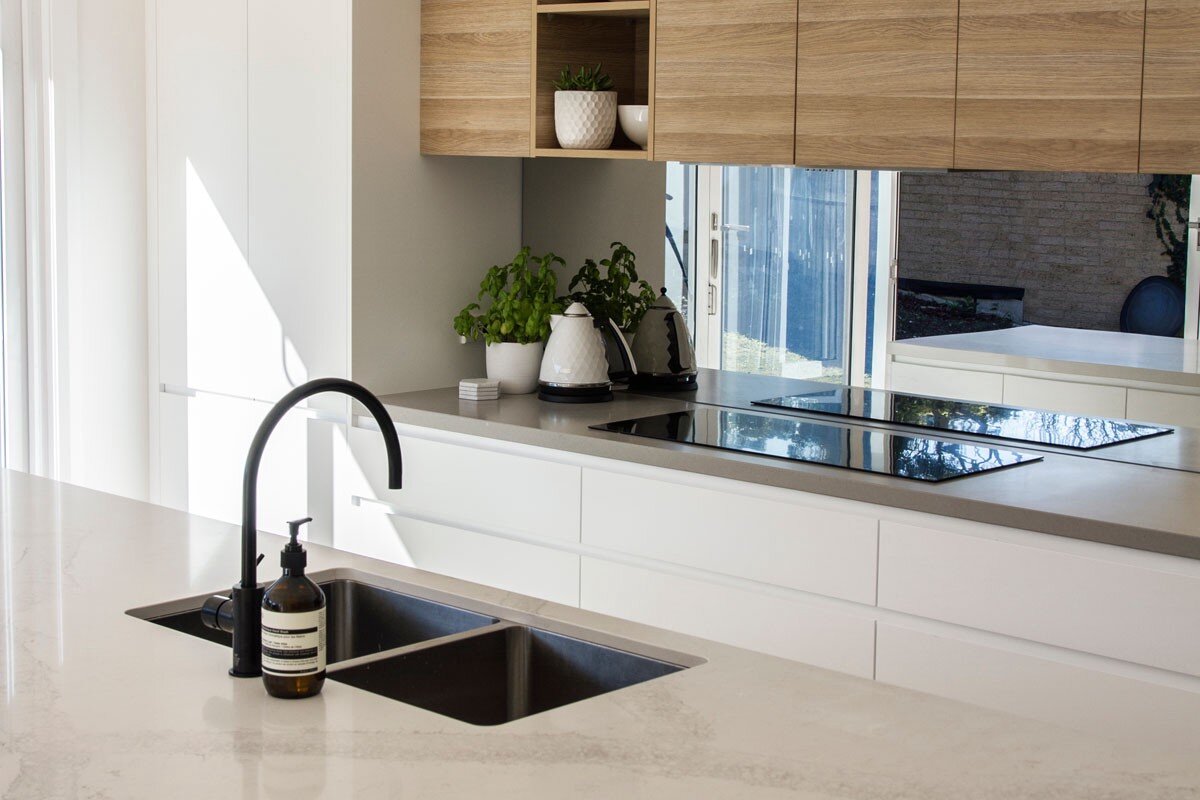The Ultimate Guide To Quartz Benchtops
Blanca Matrix by Silestone that we manufactured for Alby Turner and Son
When it comes to kitchen design — benchtops are integral. Not only are they an opportunity to wow with colour, texture and finish, they also wear the brunt of day-to-day kitchen life — making your selection all the more important.
So, how do you select your perfect surface? A good place to start is with material. There are a plethora of stone surfaces to select from: natural, sintered, porcelain, engineered….
Engineered stone, or quartz, is probably the most popular choice in modern design. It’s readily available, reasonably priced and comes in almost every shade, variation and finish imaginable.
Why did quartz become so popular?
Nobel Grey from Caesarstone. Image via Caesarstone
Raw Concrete and Calacatta Nuvo, both by Caesarstone. Image via Caesarstone.
Quartz is one of the most abundant minerals on earth, along with being one of the hardest. This combination lead manufacturers to realise its potential as a surface material — and thus the quartz bench top was born.
Quartz, made up of natural properties and man made counterparts, is now well-known as one of the most durable counter top materials on the market. Many say it is the only man made material that compares in durability and strength to natural stone (we’re not sold on that statement though.)
Pros
Aesthetics — Quartz gives you the look of natural stone without the price point. It’s been a popular choice with builders, designers and homeowners for a long time due to its three dimensional appearance and realistic finish.
Uniformity — Due to being a man-made product, quartz benchtops can have uniform appearance throughout slabs — unlike marbles and granites. If you are someone who does not want any of the imperfections or blemishes that can come as a result of using a natural product, then an engineered top could be your answer. Particularly useful when doing large kitchens that will need joins, or if you are after book matching, vein matching or waterfall ends, the manufactured consistently of engineered stone is a plus.
Durability — Due to the combination of quartz’s already naturally hard makeup, and the addition of resin binders, engineered stone is one of the most durable and trusted bench top surfaces available.
Low porosity — Quartz is not a porous surface like some natural stones. Due to the resin binders that seal the material, it is not easily penetrated by moisture and liquids. This stands in stark contrast to natural materials that need to have spills cleaned up immediately.
Scratch resistant — Many quartz brands will market their surface as being scratch resistant. This makes it a great surface for kitchen bench tops as it shouldn’t be heavily effected by knife marks.
Stain resistant — Continuing from the discussion on quartz's low porosity above — quartz shouldn’t stain from spills. Liquids such as water, juice, oil, wine, other alcoholic beverages and coffee shouldn’t effect it.
Hygienic — Because quartz surfaces don’t hold on to liquids, it makes it difficult for bacteria to grow. Also, because a lot of quartz bench top installations don’t have large/multiple joins, there is no where for grime to build up in seam areas.
Easily maintained — Quartz upkeep isn’t difficult, and requires minimal maintenance. There will be cleaning instructions for each individual brand, but most will suggest a simple solutions of mild soap and warm water to remove stains.
One seal is all you’ll need — Natural surfaces, in order to last and perform, need constant resealing. Quartz — because of treatments applied during creation — does not. This helps save both time and money — adding to the ease of maintenance.
Last the test of time — If cared for correctly, quartz tops can last for decades. Suppliers often include a 10 to 15 year warranty (although this can be easily voided with manufacture).
Easily manufactured/fabricated — Engineered stone is by far our stone fabricators favourite material to manufacture. It is easier/quicker to cut, mitre and polish.
Fino Venato by Essastone
Cons
Isn’t the cheapest choice — Although in comparison to natural stone, engineered can be more affordable — that isn’t to say it comes cheap. In fact, some premium quartz products can even exceed natural stone in price.
Not UV stable — Most quartz products are not UV stable — meaning they will eventually fade/change colour if exposed to direct sunlight/heat. In some instances, the quartz may even begin to warp and bow as a result of excess UV exposure.
Not suitable for outdoor use — Quartz products are best suited for indoor applications. Most manufacturers void warranty if a quartz product is installed outdoors, particularly if it is uncovered/exposed to the elements.
Cannot withstand extreme heat — Although a lot of quartz bench tops are heat resistant, they can’t withstand extreme heat. Quartz bench tops may experience ‘heat shock.’ This refers to when something hot meets something cold, and as a result will likely crack. Some new-age materials boast that they won’t be affected by heat shock, so if you are needing your bench top to hack the heat, then maybe quartz isn’t the right choice for you.
Might be more porous than they’d like to admit — Why do companies develop new products? To fix a hole in the market place, right? So if Quartz is as non porous as all the companies say — why did Silestone develop their N-Boost range? Seems as though there was room for improvement that Silestone took advantage of, and that maybe, quartz isn’t the most non-porous material available.
Eternal Marquina by Silestone
Colours & Designs
One of quartzs’ major pluses is its wide colour, pattern and finish options. The different colours are achievable by adding pigments to the resin and powdered quartz mixture.
Due to the ‘ease’ of creating all these different colours and variations, there are more and more brands and lines coming out every year. If homeowners want a particular design, then quartz manufacturers will make it available.
Quartz bench top edge profiles
Bench top edge profiles service multiple purposes — from improving the functionality to being a design feature.
Because engineered stone is quite an easy material to manufacture, you can achieve an array of edge profiles.
Here at SteedForm we offer all of our edges on engineered stone including arris, pencil, provincial and euro. It is the only surface that we work with that we can achieve all edges on.
Symphony Grey by Caesarsrone with an Arris edge. Manufacted by SteedForm for Kitchenext.
Symphony Grey by Caesarsrone with an Arris edge. Manufacted by SteedForm for Kitchenext.
Quartz Thickness
Most engineered products come in 20mm thickness only. There are a few brands, such as Silestone, that do come in 30mm. You would need to check with your supplier to see what colours and brands are available in different thicknesses.
Having said this - if you want an engineered product that appears 50mm, 100mm, 150mm etc. thick, quartz can be mitered to appear as thick as your heart desires.
Quartz Finishes
Most engineered products come in at least two finishes — usually a polished or matte finish. Each finish can enhance particular design styles. Although changing the appearance, a surfaces finish shouldn’t change the strength or durability of the product.
Polished Quartz Countertops
When quartz is polished it becomes highly reflective — with a distinctive glossy/shiny appearance.
Polished finishes, in any material, are often associated with opulence or grandeur. It is often found in traditional design and gives the stone a rich, vibrant colour.
Polished quartz is arguably easier to clean than its matte counter part due to its smooth surface that is less absorbent. Often, polished tops also repel smudges and fingerprints more.
Honed/Matte Quartz Countertops
Honed or matte finishes are essentially the opposite to what we discussed above — the polishing process is stopped before the material gets too shiny, leaving the quartz looking soft and smooth. A lot of the time, honed quartz appears lighter than the glossy/vibrant finish of polished quartz.
Matte surfaces are extremely popular in modern design — helping to bring an earthy and refreshing look to people’s bench tops.
Honed quartz gives a sort of concrete or slate appearance. It gives the illusion of natural stone with the durability of a man-made product.
Carbon Matte by Quantum Quartz
Venatino Statuario Polished by Quantum Quartz. Kitchen project by Premier Kitchens Australia.
Major Brands
There are a plethora of major players in the engineered stone space. The major brands that we work with the most are —
What do you think? Can engineered stone really look as good as the real deal?
Don’t forget to follow us on Facebook and Instagram.











